
 |
|
DEPTHX
~ Deep Phreatic Thermal Explorer
NASA Plans Diving Mission to Europa 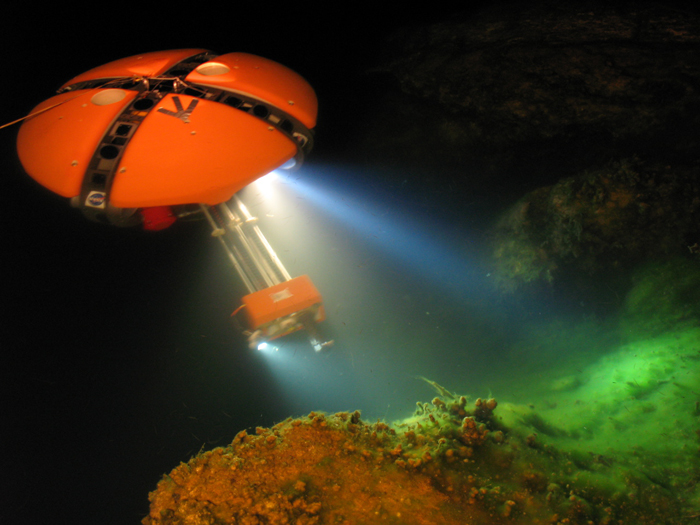 DEPTHX, the
world's first cave diving robot. Photo: Carnegie
Mellon University
Previous
expeditions tested the robotic probe that will
make the dive. The Deep Phreatic Thermal
Explorer, known as DEPTHX, is a tangerine-shaped
submarine designed to survey and explore for
life in extreme regions on Earth and potentially
in outer space. During eight years of research
at Zacatón, doctoral student Marcus Gary, who
coordinates the DEPTHX mission, and hydrogeology
professor Jack Sharp, both from The University
of Texas at Austin’s Jackson School of
Geosciences, discovered the system’s unusual
hydrothermal nature is analogous to liquid
oceans under the icy surface of Jupiter’s moon
Europa.
NASA Funded Robotic Sub makes Final dive to Reach Bottom of Earth's Deepest Sinkhole - University of Texas |
| The Deep Phreatic Thermal Explorer
(DEPTHX) is an autonomous underwater vehicle designed
and built by Stone Aerospace, an aerospace engineering
firm based in Austin, Texas. It was designed to
autonomously explore and map underwater sinkholes in
northern Mexico, as well as collect water and wall core
samples. The DEPTHX vehicle was the first of three
vehicles to be built by Stone Aerospace which were
funded by NASA with the goal of developing technology
that can explore the oceans of Jupiter's moon Europa to
look for extraterrestrial life. DEPTHX was a collaborative project for which Stone Aerospace was the principal investigator. Co-investigators included Carnegie Mellon University, which was responsible for the navigation and guidance software, the Southwest Research Institute, which built the vehicle's science payload, and research scientists from the University of Texas at Austin, the Colorado School of Mines, and NASA Ames Research Center. 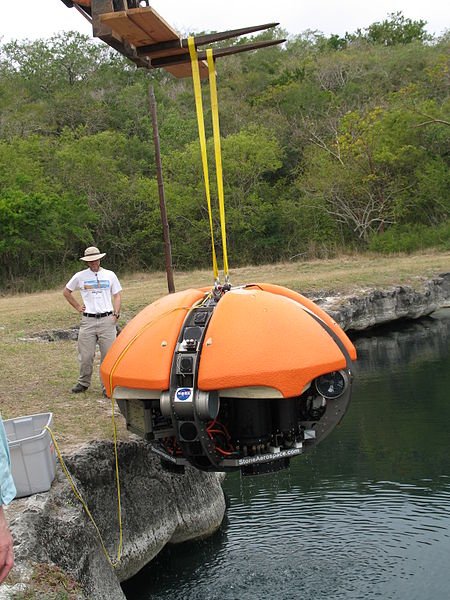 Deep Phreatic Thermal Explorer robot being lowered into La Pilita, one of several water-filled sinkholes in Sistema Zacaton (in northeastern Mexico). Photo: Marc Airhart, Wikimedia Commons The success of the DEPTHX mission led to the funding of the follow-on project, ENDURANCE. The ENDURANCE vehicle reused the frame and a number of systems from the DEPTHX vehicle, but was considerably reconfigured for the needs of the Antarctic environment SOURCE: Wikipedia Deep Phreatic Thermal Explorer (DEPTHX) |
ENDURANCE (Environmentally Non-Disturbing Under-ice Robotic Antarctic Explorer) ENDURANCE, the Environmentally
Non-Disturbing Under-ice Robotic ANtarctic Explorer,
developed by Principal Investigator Peter Doran of
the University of Illinois-Chicago in collaboration
with Stone Aerospace and other collaborators. A
modified version of the DEPTHX vehicle (see below),
ENDURANCE is an underwater robotic probe designed to
explore the biological and geochemical composition
of an ice-bound Antarctic lake. This project is
intended to demonstrate a concept that may prove
useful in the search for life on other planetary
bodies where ice is known to exist. In February
2008, as a prelude to full-blown field operations in
Antarctica, Doran’s team will conduct a field
demonstration of ENDURANCE in an ice-covered lake in
Madison, Wisconsin. During the 2008-2009 field
research season in Antarctica, ENDURANCE will map
the continent’s West Lake Bonney, a two-and-a-half
mile long, one-mile wide, 130 foot-deep lake located
in the continent’s Dry Valleys. The lake is
perpetually covered with 12 to 15 feet of ice.
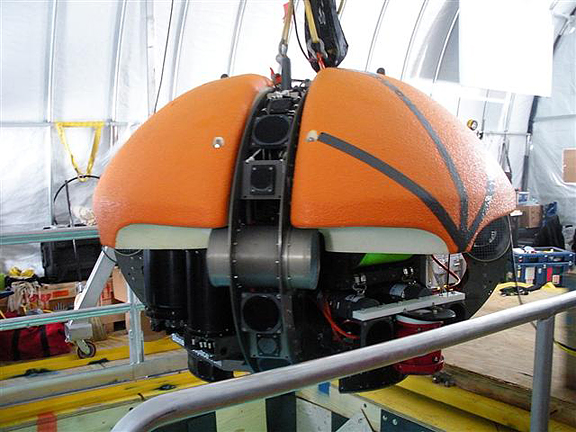 Courtesy
Stone Aerospace
|
| Papers: |
Potential for Extraterrestrial Life 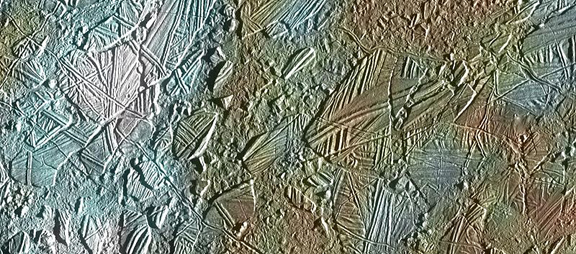 Chaotic
ice crust in the Conamara region of Europa.
Conamara has the appearance of a site at which
the crust had melted allowing blocks of ice to
shift positions by floating to new locations
before refreeze took place (Greenberg, 2005).
Credit NASA..
Europa has emerged as one of the top locations in
the Solar System in terms of potential habitability
and the possibility of hosting extraterrestrial life.
Life could exist in its under-ice ocean, perhaps
subsisting in an environment similar to Earth's
deep-ocean hydrothermal vents. Life in such an ocean
could possibly be similar to microbial life on Earth
in the deep ocean. So far, there is no evidence that
life exists on Europa, but the likely presence of
liquid water has spurred calls to send a probe there.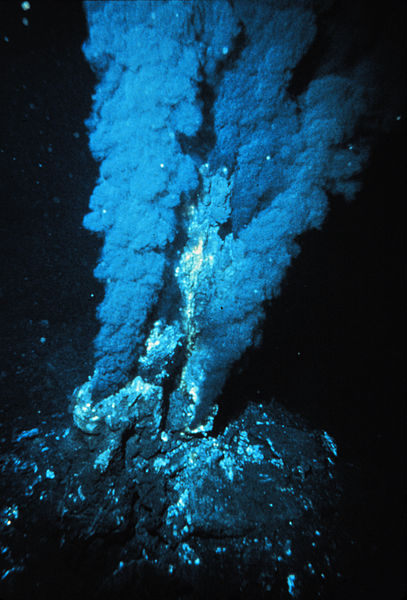 A
black smoker in the Atlantic Ocean. Driven by
geothermal energy, this and other types of
hydrothermal vents create chemical
disequilibria that can provide energy sources
for life. Credit: P. Rona, Wikimedia
Commons
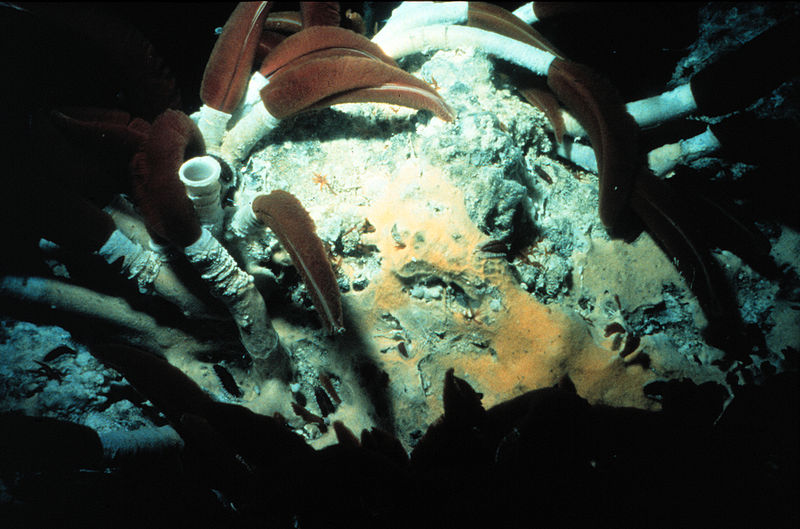 This
giant tube worm colony dwells beside a Pacific
Ocean vent. Although the worms require oxygen
(hence their blood-red color), methanogens and
some other microbes in the vent communities do
not. Credit; C. Van Dover (OAR/National Undersea
Research Program (NURP); College of William
& Mary) Wikimedia Commons
Although the tube worms and other multicellular eukaryotic organisms around these hydrothermal vents respire oxygen and thus are indirectly dependent on photosynthesis, anaerobic chemosynthetic bacteria and archaea that inhabit these ecosystems provide a possible model for life in Europa's ocean. The energy provided by tidal flexing drives active geological processes within Europa's interior, just as they do to a far more obvious degree on its sister moon Io. Although Europa, like the Earth, may possess an internal energy source from radioactive decay, the energy generated by tidal flexing would be several orders of magnitude greater than any radiological source. However, such an energy source could never support an ecosystem as large and diverse as the photosynthesis-based ecosystem on Earth's surface. Life on Europa could exist clustered around hydrothermal vents on the ocean floor, or below the ocean floor, where endoliths are known to inhabit on Earth. Alternatively, it could exist clinging to the lower surface of Europa's ice layer, much like algae and bacteria in Earth's polar regions, or float freely in Europa's ocean. However, if Europa's ocean were too cold, biological processes similar to those known on Earth could not take place. Similarly, if it were too salty, only extreme halophiles could survive in its environment. In September 2009, planetary scientist Richard Greenberg calculated that cosmic rays impacting on Europa's surface convert some water ice into free oxygen (O2), which could then be absorbed into the ocean below as water wells up to fill cracks. Via this process, Greenberg estimates that Europa's ocean could eventually achieve an oxygen concentration greater than that of Earth's oceans within just a few million years. This would enable Europa to support not merely anaerobic microbial life but potentially larger, aerobic organisms such as fish. 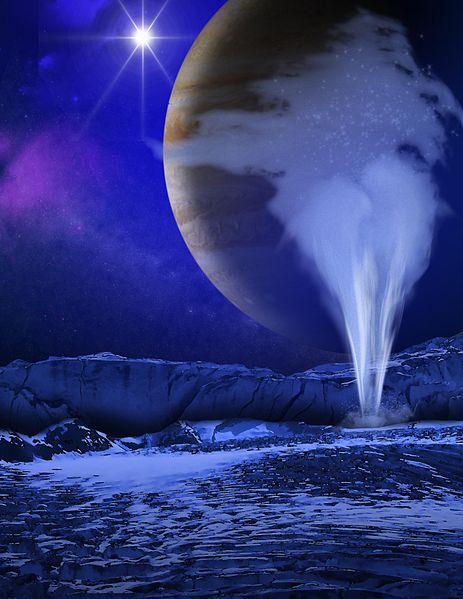 Water
Vapor Plume on Europa (artist concept) (December
12, 2013). Courtesy:
NASA
In 2006, Robert T. Pappalardo, an assistant
professor in the Laboratory for Atmospheric and Space
Physics at the University of Colorado in Boulder said,This is an
artist's concept of a plume of water
vapor thought to be ejected off the
frigid, icy surface of the Jovian moon
Europa, located about 500 million
miles (800 million kilometers) from
the sun. Spectroscopic measurements
from NASA's Hubble Space Telescope led
scientists to calculate that the plume
rises to an altitude of 125 miles (201
kilometers) and then it probably rains
frost back onto the moon's surface.
Previous findings already pointed to a
subsurface ocean under Europa's icy
crust.
The Hubble Space Telescope is a project of international cooperation between NASA and the European Space Agency. NASA's Goddard Space Flight Center manages the telescope. The Space Telescope Science Institute (STScI) conducts Hubble science operations. STScI is operated for NASA by the Association of Universities for Research in Astronomy, Inc., in Washington, D.C. We’ve spent quite a bit of time and effort trying to understand if Mars was once a habitable environment. Europa today, probably, is a habitable environment. We need to confirm this … but Europa, potentially, has all the ingredients for life … and not just four billion years ago … but today.In November 2011, a team of researchers presented evidence in the journal Nature suggesting the existence of vast lakes of liquid water entirely encased in Europa's icy outer shell and distinct from a liquid ocean thought to exist farther down beneath the ice shell. If confirmed, the lakes could be yet another potential habitat for life. A paper published in March 2013 suggests that hydrogen peroxide is abundant across much of the surface of Jupiter's moon Europa. The authors argue that if the peroxide on the surface of Europa mixes into the ocean below, it could be an important energy supply for simple forms of life, if life were to exist there. The scientists think hydrogen peroxide is an important factor for the habitability of the global liquid water ocean under Europa's icy crust because hydrogen peroxide decays to oxygen when mixed into liquid water. On December 11, 2013, NASA reported the detection of "clay-like minerals" (specifically, phyllosilicates), often associated with organic materials, on the icy crust of Europa. The presence of the minerals may have been the result of a collision with an asteroid or comet according to the scientists. On December 12, 2013, NASA announced, based on studies with the Hubble Space Telescope, that water vapor plumes were detected on Europa and were similar to water vapor plumes detected on Enceladus, moon of Saturn. Source: Wikipedia Europa (moon) |
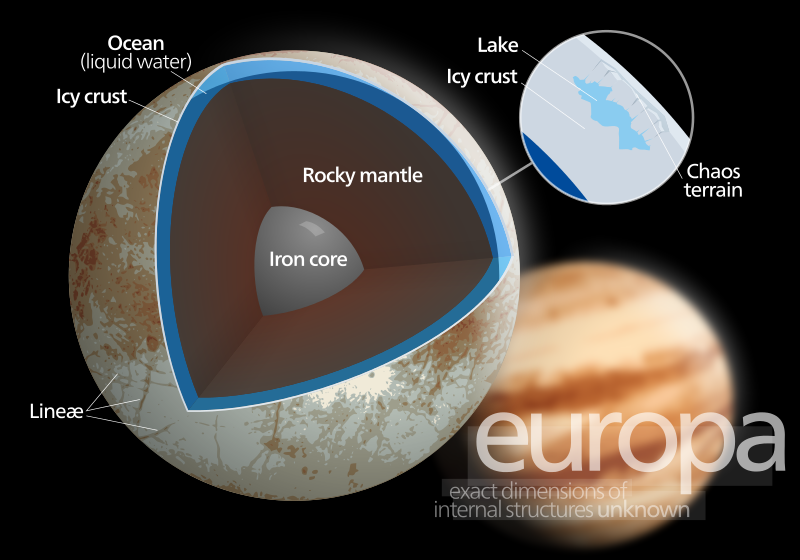 Poster showing the structure and features of europa. Editable text is outside the SVG frame. Credit: Kelvinsong, Wikimedia Commons |
| See
Also: Papers:
|
|
All material on these pages, unless
otherwise noted, is
© Pegasus Research Consortium 2001-2019 |
 Webpages © 2001-2019 Pegasus Research Consortium |